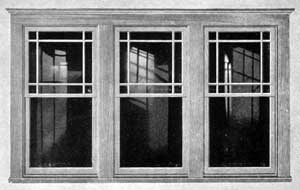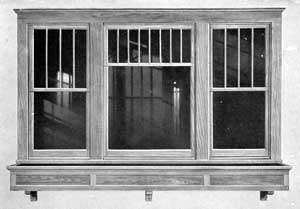Small Home Gazette, Summer 2008
Windows: To Replace or Not to Replace?
An interview with Tom Guelcher, owner of the Turning Point Woodworks
This article was reprinted with permission by the Preservation Alliance of Minnesota.
Douma, Amy. “Windows: To Replace or Not to Replace?” The Minnesota Preservationist. Vol. 11, no. 2. March–April 2008.
While preservation and sustainable design are closely aligned on most points, there are a couple of issues that can lead to debate. One of these is the question of existing windows, and whether it’s more “sustainable” to replace them or to retain them.
Most are familiar with the arguments for replacement. Newer technology has significantly improved window energy performance; on the surface, replacement would seem “sustainable” because it can reduce a building’s energy consumption. On the other hand, preservationists know that historical windows can greatly contribute to the character of a building, and replacement is typically a last resort. In addition, window replacement results in demolition debris and the use of raw materials. So which approach is more sustainable?
As Tom Guelcher from the Turning Point Woodworks explains, there are many reasons to keep existing windows, from historical character to ease of maintenance. In addition, there are a number of ways to improve their energy performance without resorting to full replacement.
 Exchanging old windows to new ones—good idea or not?
Exchanging old windows to new ones—good idea or not?
Generally, I advise against it. However, there are some quality new windows on the market. New windows do hold out the cold better, and can sometimes be cleaned both inside and out from the inside.
When is it appropriate to replace windows?
When windows have been cut down for sash liners and do not perform well anymore and when windows are rotted or in really bad shape, it is appropriate to consider replacing them.
What are the advantages of keeping the older windows?
For starters, old window systems have storm windows (now mostly combinations). The storm or combination will protect the sill since it projects outward from the sashes. Old windows are easier to maintain; you can paint them or fix them by yourself. They also help an older home hold its value.
How do windows affect the resale value of a house?
Mostly, it depends on the house and the buyer. New windows can be a selling point if they are fairly new and of a good quality. However, someone interested in restoring or preserving a vintage home will usually prefer a house with its original windows. Original windows can be very appealing with their wavy glass and true divided lights. As mentioned above, they can be maintained or repaired by the homeowner or local hardware store. Due to being constructed from old growth wood, original windows (those that came with an older home when it was first built) will still outlast any replacement windows when combined with periodic maintenance. Newer windows are often difficult to maintain and have a definite life expectancy, which usually leads to a total replacement of the unit at some point.
What is old growth wood?
Older homes, most of those built before 1936, were constructed from wood culled from natural forests that were not planted or maintained by man. The trees were wild and would have sustained natural hardships on their own. For this reason, they made the perfect building material with much longer durability than the wood of today. Today’s wood is a hybrid of three different woods. It’s called SPF lumber meaning spruce, pine and fir. Spruce because it grows fast; pine because it is workable; and fir because it is hearty, durable and strong. However, the wood does not last very long when compared with the “wild” growing trees. On average, our new wood has a life expectancy of about 10 years when exposed to the elements.
What about energy efficiency?
Often, homeowners are worried about an older window’s efficiency. It is true that older windows are draftier than newer windows; however, with the right maintenance and good, tight-fitting storm windows or combinations, an older window can come close to the efficiency of a newer window.
Wind and air infiltration on an older window may not come from the window sash or casing, but from the weight pockets alongside the casing. This is the hollow space needed for the up-and-down movement of the weights that keep the sash open or closed. Many people will take the weights out, stuff these hollow spaces full of insulation, and install sash liners so the sashes still have enough resistance from the (tensioned) sides to stay open. Another option is to open up these hollow spaces—usually from the exterior—and put the weights within pieces of tubing and then insulate around the tubing. It is also a good idea to exchange the rope holding the weights to sash chain, which doesn’t break.
 In conclusion, original windows help retain the integrity of what defines a vintage home; without them, the character and charm of a vintage home is often lost. While concern for energy efficiency is important, it isn’t the only issue to be considered, especially when there are options for improving the energy efficiency of a home’s existing windows.
In conclusion, original windows help retain the integrity of what defines a vintage home; without them, the character and charm of a vintage home is often lost. While concern for energy efficiency is important, it isn’t the only issue to be considered, especially when there are options for improving the energy efficiency of a home’s existing windows.
Turning Point Woodworks specializes in interior and exterior painting and in woodworking. They are located at 1270 Grand Avenue, St. Paul. Phone 651-698-4227 or
www.theturningpointwoodworksinc.com.
Interested in preserving Minnesota’s historic resources? Join the Preservation Alliance of Minnesota (PAM). The Alliance is Minnesota’s only state-wide, non-profit organization dedicated to preserving, protecting and promoting Minnesota’s historic resources. More information at www.mnpreservation.org.











